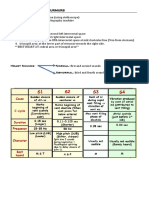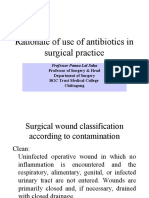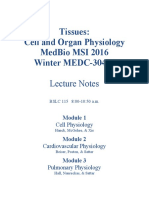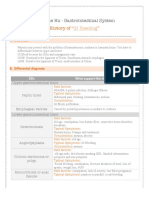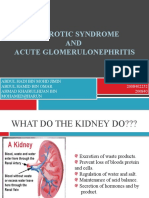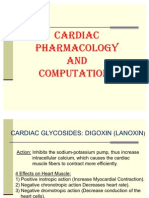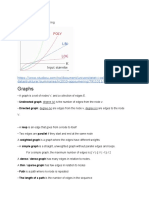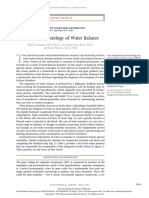CVS Examination Edited
CVS Examination Edited
Uploaded by
Thilak JayalathCopyright:
Available Formats
CVS Examination Edited
CVS Examination Edited
Uploaded by
Thilak JayalathCopyright
Available Formats
Share this document
Did you find this document useful?
Is this content inappropriate?
Copyright:
Available Formats
CVS Examination Edited
CVS Examination Edited
Uploaded by
Thilak JayalathCopyright:
Available Formats
Examination of
Cardiovascular
System
First impression
Inherited syndromes
Down's syndrome (PDA, ASD & VSD)
Marfan's syndrome (aortic dissection,
valve disease)
Turner's syndrome (aortic coarctation
& aortic stenosis)
Ankylosing spondylitis
(aortic regurgitation)
Acromegaly
(hypertension &
cardiomegaly)
Other syndromes
Downs syndrome
Marfan s
syndrome
Turner s syndrome
Turner s syndrome
Acromegaly
Acromegaly
General
Examination
Breathlessness
In pain
Febrile
Pallor
Xanthelesma
Xanthelesma
Cleft ear lobes
Central cyanosis
Dental care
Thyroid enlargement
Central cyanosis
Clubbing of the fingers
Splinter heamorrhages
Splinter haemorrhages
Oslers nodes
Janeways lesions
Ankle oedema
Sacral oedema
Pulse
Presence or absence
Rate
Rhythm
Character
Presence of bruits
Jugular venous pulse
Jugular venous pressure
The internal jugular vein provides
information about right atrial and right
ventricular function
The jvp can be discriminated from the carotid pulse
because:
It cannot be palpated
It has a complex wave form; it is usually seen to flicker
twice within each cardiac cycle
It moves on respiration, normally decreasing on inspiration
and rising on expiration
Mild pressure applied to the base of the neck obliterate its
pulsations
Mild pressure applied over the liver will expel more blood
into the right side of the heart and elevate the jvp, a
positive hepato-jugular reflex
Jugular venous wave pattern
The jvp is described in terms of:
Height
character
The height of the jvp is expressed as the
vertical distance from the manubriosternal
angle to the maximum height of pulsations
in the internal jugular vein with the patient
semi-recumbent at an angle of 45 degrees
It is normally less than 3 cm.
This equates to a right atrial pressure of 8
cm of water as in this position, the
manubriosternal angle is about 5 cm
above the centre of the right atrium
Causes of a raised jvp
increased right ventricular filling pressure
obstruction of blood flow from the right atrium
to the right ventricle
superior vena caval obstruction
positive intrathoracic pressure
Abnormal waves
Abnormally large a waves indicate
increased resistance to right atrial emptying
from right ventricular hypertrophy, as in
severe pulmonary stenosis, or tricuspid
stenosis.
Abnormal waves
A waves are absent in atrial fibrillation,
since coordinated atrial contraction is
necessary to produce them,
Abnormal waves
Cannon waves are very large a waves that
occur when the right atrium contracts against a
closed tricuspid valve.
They occur irregularly in complete heart block
and ventricular tachycardia, conditions that
are characterised by atrioventricular
dissociation with random occasional
simultaneous atrial and ventricular
contractions.
An exaggerated x descent indicates that
blood is being ejected from a restricted
pericardial cavity, for example, because
of cardiac tamponade or constrictive
pericarditis without calcification.
A slow y descent may be seen in
tricuspid stenosis and right atrial
myxoma.
Examination of the
precordium
Scars,
The midline scar of a sternotomy
The left lateral scar of a mitral
valvotomy
Deformity
Pacemaker
Visible apex beat or other pulsation
Inspection
Pectus excavatum
Palpation
Apex beat
Parasternal haeve
Palpable heart sounds
Plapable murmurs
Apex beats different types
Sustained or heaving apex beat is
caused by pressure overload
aortic stenosis,
severe hypertension.
Apex beats different types
Tapping apex beat seen in
Mitral stenosis
Apex beats different types
Thrusting displaced apex beat is
caused by volume overload: an
active large stroke volume ventricle
Aortic regurgitation
Mitral regurgitation
Left to right shunts.
Apex beats different types
Double or triple impulse occur in
Hypertrophic obstructive
cardiomyopathy
Apex beats different types
An impalpable apex beat
Obesity
Overinflated chest
Pericardial effusion
Dextrocardia
Apex beat
Parasternal heave is detected by
placing the heel of the hand over
the left parasternal region. In the
presence of a heave the heel of the
hand is lifted off the chest wall with
each systole.
Parasternal haeve
Parasternal heave is caused by:
Right ventricular enlargement
Severe left atrial enlargement
which pushes the right ventricle
forwards
Thrill
These are palpable murmurs
They always indicate an organic defect
The area where the thrill is felt strongest
gives clues as to the aetiology of the thrill
Thrills may be
Systolic or diastolic:
Best felt site suggest the oetiology
Systolic:
Apex mitral incompetence
at 3rd or 4th interspace vsd
At base on right aortic stenosis
at base on the left pulmonary stenosis
Below left clavicle - pda
Diastolic:
Apex mitral stenosis
Accurate and sensitive
auscultation of the
praecordium requires
experience
Location of heart valves
Auscultation should begin in the mitral
region:
Use the bell initially to detect the low
frequency sounds of mitral stenosis or a
third heart sound
Use the diaphragm to detect the higher
frequency sounds of mitral incompetence
or a fourth heart sound
Using the bell and diaphragm, listen
in the following locations
Tricuspid area
Pulmonary area
Aortic area
Never forget to
Auscultate over the mitral
area in left lateral position in
expiration with the bell to find
mid diastolic murmur in mitral
stenosis
Never forget to
Auscultate over the lower
left sternal edge in
expiration , in seated and
bent forward position, with
the diaphram to find early
diastolic murmur in aortic
incompetence
Heart sounds
There are two major groups of heart
sounds
They are classified according to their
mechanism,
Valvular
Ventricular filling
Valve sounds
These include:
First heart sound
Second heart sound
ejection sounds
opening snaps
The first heart sound is caused by
the closing of the mitral valve
and the closing of the tricuspid
valve
It is heard loudest at the apex.
Possible causes of a soft first heart
sound include
Mitral regurgitation
low blood pressure,
rheumatic carditis
severe heart failure
left bundle branch block
Loud first sounds
A loud first heart sound occurs when the
leaflets are wide open at the end of
ventricular diastole and shut forcefully at
the beginning of ventricular systole.
Causes of loud first heart sound
Atrial fibrillation
short diastole tachycardia
Atrial premature beat
Mitral stenosis where high left atrial
pressure delays mitral valve closure
If the blood flow from atria to ventricles
varies from one beat to the next, then
the intensity of the first heart sound will
change accordingly
Causes include
Varying duration of diastole
Complete atrioventricular block
A soft, or absent, a2 is heard in:
Poorly mobile cusps
calcification as occurs in some forms of
aortic stenosis
dilatation of the aortic root - syphilitic
aortitis
A soft, or absent, p2 is heard in:
Pulmonary stenosis
Loud second heart sounds can be loud
a2 or a loud p2.
Loud a2 occurs in systemic hypertension
where there is a dilated proximal aorta
A loud p2 is heard in pulmonary
hypertension
Splitting of second heart sound
A2 and p2 separate on inspiration
(P2 following a2)
This is because of the increased right
ventricular stroke volume that occurs as
the result of increased venous return
The second heart sound is widely split if
there is an early a2 or if the p2 is
delayed.
Early A2 can occur in
Mitral regurgitation
Ventricular septal defect
Delayed p2
Possible causes include :-
Right bundle branch block
Pulmonary stenosis
Atrial septal defect
Fixed splitting
Splitting of seond heart sound in
both inspiration and expiration
Reversed splitting
In this condition, p2 occurs before a2
On expiration, a2 is delayed such that it
occurs after p2
Inspiration causes p2 to be delayed and
the split is diminished.
Possible causes of a delayed a2
Left bundle branch block
systolic hypertension
severe aortic stenosis or hocm
patent ductus arteriosus
left heart failure
Ejection clicks
These are caused by the opening of the
aortic and pulmonary valves.
These sounds are high pitched and often
described as clicky.
They occur in early systole and are best
heard with a rigid diaphragm chest piece.
Opening snaps
In certain pathological states the av
valves open more rapidly than normal,
this results in an audible opening snap.
A mitral opening snap may be
caused by:
Mitral stenosis with a mobile valve
Rapid mitral flow causes a soft snap in left
to right shunts such as
Vsd or pda.
Severe mitral regurgitation
A tricuspid opening snap is rare and may
be caused by:
Rheumatic stenosis
Atrial septal defect with increased
tricuspid flow
Filling sounds
These sounds are of much lower frequency than
the valve sounds and may be difficult to hear.
They are best heard with the bell gently applied
to the chest and are described as a dull thud
becoming palpable when loud.
Ventricular filling sounds include:
Rapid filling (third)
Atrial (fourth)
Third heart sound
This heart sound is caused by rapid
ventricular filling in early diastole.
The third sound is normally audible in
children, with the intensity diminishing
with age.
The third heart sound becomes
inaudible (but recordable) in normal
subjects in middle age with increasing
ventricular stiffness.
Fourth heart sound
The fourth heart sound is due to atrial
contraction inducing ventricular filling
towards the end of diastole.
They are never audible in normal
subjects.
A fourth heart sound is the result of
powerful atrial contraction filling an
abnormally stiff ventricle.
Left atrial heart sound is maximal at the
apex, with possible causes including:
Left ventricular hypertrophy
fibrotic left ventricle
hypertrophic cardiomyopathy
Right atrial heart sound is maximal at the
lower left sternal edge and on inspiration.
This may occur in
Right ventricular hypertrophy
Murmurs
Heart murmurs are caused by
turbulent blood flow through
valves or ventricular outflow
tracts
Characteristics of heart murmurs
Timing
Duration
Character and pitch
Intensity
Location
Radiation
Murmurs are recorded in six gradations:
1/6 murmur is just audible by an expert in optimal
conditions
2/6 is quiet
3/6 is moderately loud
4/6 is markedly loud , accompanied by a thrill
5/6 is very loud with a thrill
6/6 is audible without a stethoscope
With reference to valvular lesions
Systolic murmurs imply incompetence of
atrioventricular valve or stenosis/sclerosis
of semilunar valve.
Diastolic murmurs imply stenosis of
atrioventricular valve or incompetence of
semilunar valve
Left ventricular ejection murmurs are
maximal at the aortic area, lower left
sternal edge and apex.
Possible causes include:
Aortic stenosis
Hypertrophic obstructive
cardiomyopathy
aortic cusp sclerosis
Ejection systolic murmur maximal over
the aortic area:
Aortic stenosis
Aortic sclerosis
Coarctation of the aorta
Hypertrophic cardiomyopathy
Ejection systolic murmur maximal over
the pulmonary area:
Innocent
pulmonary stenosis
pulmonary hypertension
atrial septal defect
Pansystolic murmurs
Pansystolic murmurs occur throughout
systole
Caused by:
Mitral regurgitation
Ventricular septal defect
tricuspid regurgitation
Diastolic murmurs
Early diastolic murmurs
Mid-diastolic murmurs
Early diastolic murmurs
Aortic regurgitation - maximal at the 4th
interspace below the aortic valve.
Maximal if the patient leans forwards.
Radiates to the back.
Pulmonary regurgitation - maximal about
the third left space.
Mid diastolic murmurs
Mitral stenosis - maximal at the apex with
the patient inclined to the left. The murmur
begins after the opening snap. The
murmur is long if severe and short if mild.
Tricuspid stenosis - maximal at the lower
left sternal edge. The murmur is increased
by inspiration.
A murmur mimicking mitral stenosis may
occur when there is greatly increased
flow across the mitral valve.
This may occur in
mitral regurgitation,
Ventricular septal defect
Patent ductus arteriosus
Continuous murmur
These occur when there is a
communication in the circulation with a
continuous pressure gradient throughout
the cardiac cycle.
Continuous murmurs are often maximal in
late systole
Causes of a continuous murmur include:
Patent ductus arteriosus
aortic sinus of valsalva aneurysm rupturing into
the right heart
pulmonary arteriovenous communications
Bronchial artery anastomosis in pulmonary
atresia
Artificial ducts
prosthetic valve
Venous hum
Innocent murmurs
Many babies and children have heart
murmurs in the absence of any structural
abnormality
If a murmur has any of the following
characteristics then it probably is not innocent:
Pansystolic
diastolic
loud or long
associated with a thrill or cardiac symptoms
.`
Some hints concerning listening for
murmurs:
Time the cardiac cycle by palpating one of the
patient's carotid arteries
The bell is good for hearing low-pitched sounds
e.G. Mitral stenosis. It should be applied very
gently to the skin
The diaphragm is good for listening to high
pitched mumurs e.G. Aortic regurgitation
Some hints concerning listening for
murmurs:
Left heart murmurs are louder in expiration
Right heart murmurs are louder in
inspiration
Exercise makes a mitral stenotic murmur
louder
END
You might also like
- A Practical Guide To Kinesiology Taping For Injury Prevention and Common Medical Conditions (John Gibbons) (Z-Library)Document105 pagesA Practical Guide To Kinesiology Taping For Injury Prevention and Common Medical Conditions (John Gibbons) (Z-Library)alejuan252100% (1)
- Fletcher Bolter Op ManualDocument56 pagesFletcher Bolter Op Manualbannet100% (1)
- MACRAME Project PlanDocument5 pagesMACRAME Project PlanIvy Talisic100% (1)
- Abnormal Heart Sounds: First Heart Sound (S)Document4 pagesAbnormal Heart Sounds: First Heart Sound (S)Faris Mufid MadyaputraNo ratings yet
- Approach To Cardiac MurmursDocument11 pagesApproach To Cardiac Murmurstouthang0074085No ratings yet
- 7th Heart Sounds and MurmursDocument6 pages7th Heart Sounds and MurmursbabibubeboNo ratings yet
- Ebstein Anomaly, A Simple Guide To The Condition, Diagnosis, Treatment And Related ConditionsFrom EverandEbstein Anomaly, A Simple Guide To The Condition, Diagnosis, Treatment And Related ConditionsNo ratings yet
- A Simple Guide to Abdominal Aortic Aneurysm, Diagnosis, Treatment and Related ConditionsFrom EverandA Simple Guide to Abdominal Aortic Aneurysm, Diagnosis, Treatment and Related ConditionsNo ratings yet
- Clinical SignsDocument26 pagesClinical SignswiraandiniNo ratings yet
- GI Exam (RCT)Document6 pagesGI Exam (RCT)kenners100% (11)
- Heart Sounds: Mitral Regurgitation Congestive Heart FailureDocument6 pagesHeart Sounds: Mitral Regurgitation Congestive Heart FailurecindyNo ratings yet
- 4 Abdominal+ExaminationDocument9 pages4 Abdominal+Examinationمرتضى حسين عبدNo ratings yet
- Pons MedullaDocument32 pagesPons MedullaEnaWahahaNo ratings yet
- Examination of Cardiovascular SystemDocument24 pagesExamination of Cardiovascular SystemThilak JayalathNo ratings yet
- Lecture 2: The Heart: Prof. Magidah Alaudi, M.SCDocument62 pagesLecture 2: The Heart: Prof. Magidah Alaudi, M.SCMonicaNo ratings yet
- Syncope and PalpitationsDocument1 pageSyncope and PalpitationsTom MallinsonNo ratings yet
- Asthma Review PDFDocument12 pagesAsthma Review PDFdanielc503No ratings yet
- Chap253-Heart Failure ManagementDocument42 pagesChap253-Heart Failure ManagementDoctor CastleNo ratings yet
- 1.rationale of Use of Antibiotic in Surgical Patients CDocument22 pages1.rationale of Use of Antibiotic in Surgical Patients CPanna SahaNo ratings yet
- Vessels and CirculationDocument67 pagesVessels and CirculationTio UgantoroNo ratings yet
- TelemetryDocument3 pagesTelemetryKelly PrattNo ratings yet
- Diagnoses and Management Acute Headache Emergency DepartmentDocument37 pagesDiagnoses and Management Acute Headache Emergency DepartmentBendy Dwi IrawanNo ratings yet
- Physio Coursepack 2016Document282 pagesPhysio Coursepack 2016Amanda KimNo ratings yet
- GI Bleeding HXDocument3 pagesGI Bleeding HXBitu JaaNo ratings yet
- Cardiovascular: Surfaces of The HeartDocument6 pagesCardiovascular: Surfaces of The HeartironNo ratings yet
- Cardiac GlycosidesDocument8 pagesCardiac GlycosidesShan Sicat100% (1)
- 1 - Internal Medicine UKIDocument128 pages1 - Internal Medicine UKILewishoppusNo ratings yet
- Rama Id ConceptDocument49 pagesRama Id ConceptpiangpornNo ratings yet
- NEPHROTIC SYNDROME - HamidDocument20 pagesNEPHROTIC SYNDROME - HamidAbdul Hamid OmarNo ratings yet
- Medicine Mneumonics - Copy - 4 - 2Document110 pagesMedicine Mneumonics - Copy - 4 - 2mumbafortune05No ratings yet
- Cardiac Drugs HypertensionDocument5 pagesCardiac Drugs HypertensionEciOwnsMeNo ratings yet
- CVS Examination 3rd MBDocument30 pagesCVS Examination 3rd MBsnowlover boyNo ratings yet
- Pediatric Emergency Medicine Resource 33164 - CSDY - FeverDocument7 pagesPediatric Emergency Medicine Resource 33164 - CSDY - FevervannesNo ratings yet
- Milrinone Can ONLY Be Mixed With NS!: Alpha 1 Beta 1 & Alpha 1Document1 pageMilrinone Can ONLY Be Mixed With NS!: Alpha 1 Beta 1 & Alpha 1njones33No ratings yet
- Mild Pain Treatment Algorithm: Pain Scale Rating 1/5 (0-5 Scale) or 1-3/10 (0-10 Scale)Document4 pagesMild Pain Treatment Algorithm: Pain Scale Rating 1/5 (0-5 Scale) or 1-3/10 (0-10 Scale)VickyNo ratings yet
- 132 Emergency MedicineDocument14 pages132 Emergency MedicineVania NandaNo ratings yet
- WWW Cram Com Flashcards Hematology Slides 872178Document8 pagesWWW Cram Com Flashcards Hematology Slides 872178Anonymous t5TDwdNo ratings yet
- Acute Asthma Exacerbation in AdultsDocument84 pagesAcute Asthma Exacerbation in AdultsAkif Ahamad100% (1)
- CerebellumDocument8 pagesCerebellumMohamed Hassan MohamudNo ratings yet
- Pharmacology RevisedDocument59 pagesPharmacology Revisedjohnstockton12100% (1)
- UTIDocument17 pagesUTIBongkotchakorn Mind PhonchaiNo ratings yet
- Story Board Internal MedicineDocument7 pagesStory Board Internal MedicineSarafina ElwindyNo ratings yet
- Pulmonary EmbolismDocument12 pagesPulmonary EmbolismJohn Paul MatienzoNo ratings yet
- Thrombolytics - Hematology - Medbullets Step 1Document5 pagesThrombolytics - Hematology - Medbullets Step 1aymen100% (1)
- ECG at A GlanceDocument53 pagesECG at A GlancePetrus TjiangNo ratings yet
- Cardiac InvestigationsDocument17 pagesCardiac InvestigationsTARIQ50% (2)
- PharmacologyDocument120 pagesPharmacologyFluffy_iceNo ratings yet
- GIS Modul 3 History Taking & Physical Examination of Diarrhea%Document3 pagesGIS Modul 3 History Taking & Physical Examination of Diarrhea%Windu Kumara100% (1)
- Pathophysiology of Congenital Heart Diseases PDFDocument8 pagesPathophysiology of Congenital Heart Diseases PDFdramitjainNo ratings yet
- Vital SignsDocument2 pagesVital SignsVSNo ratings yet
- Action Potential ECGDocument11 pagesAction Potential ECGAndrei ManeaNo ratings yet
- 115-NCLEX-RN Review Made Incredibly Easy, Fifth Edition (Incredibly Easy Series) - Lippincott-16083 - p87Document1 page115-NCLEX-RN Review Made Incredibly Easy, Fifth Edition (Incredibly Easy Series) - Lippincott-16083 - p87MuhNatsirNo ratings yet
- DVTDocument46 pagesDVTLuqman ArifNo ratings yet
- Cardiovascular BigDocument37 pagesCardiovascular Bigfaiz nasirNo ratings yet
- Audiometry Screening and Interpretation Aafp PDFDocument8 pagesAudiometry Screening and Interpretation Aafp PDFMaram AbdullahNo ratings yet
- JVP - WL GanDocument1 pageJVP - WL GanWeh Loong GanNo ratings yet
- Paeds Revisional SummaryDocument48 pagesPaeds Revisional SummaryJujhar BoparaiNo ratings yet
- TABLE 132 - Recreational Substances - Intoxication WithdrawalDocument3 pagesTABLE 132 - Recreational Substances - Intoxication WithdrawalDragutin PetrićNo ratings yet
- Medicine CPDocument127 pagesMedicine CPDipesh Shrestha100% (1)
- Biostatistics - Epidemiology Book 2023 (B&B) (Medicalstudyzone - Com)Document52 pagesBiostatistics - Epidemiology Book 2023 (B&B) (Medicalstudyzone - Com)Vincent DaoNo ratings yet
- Physiology of PainDocument43 pagesPhysiology of PainNashwan ANo ratings yet
- Essential DrugsDocument358 pagesEssential Drugsshahera rosdiNo ratings yet
- Community-Acquired Pneumonia: Strategies for ManagementFrom EverandCommunity-Acquired Pneumonia: Strategies for ManagementAntoni TorresRating: 4.5 out of 5 stars4.5/5 (2)
- Oil Gas Corporate Business Plan DevelopmentDocument6 pagesOil Gas Corporate Business Plan Developmentmule abadiNo ratings yet
- Mces MCQDocument50 pagesMces MCQshrimanNo ratings yet
- Vidya Bharti Ncert Chemistry Half Yearly Exam Paper #Paper LeakDocument4 pagesVidya Bharti Ncert Chemistry Half Yearly Exam Paper #Paper LeakAaditya KumarNo ratings yet
- Service Manual Videocon Ff-Vz330l, 280l, 250lDocument39 pagesService Manual Videocon Ff-Vz330l, 280l, 250ljitendraNo ratings yet
- HC Brochure 2019Document33 pagesHC Brochure 2019abul_1234No ratings yet
- Kumait@steelplantech - Co.jp Kikkawat@steelplantech - Co.jpDocument10 pagesKumait@steelplantech - Co.jp Kikkawat@steelplantech - Co.jpSANTOSH TIWARINo ratings yet
- The Apocalypse of ElijahDocument8 pagesThe Apocalypse of Elijahkamion0100% (1)
- Ball-Flange Impact Using Surface To Surface Contact ElementsDocument8 pagesBall-Flange Impact Using Surface To Surface Contact Elementsrishit_aNo ratings yet
- IN2010 Structured NotesDocument24 pagesIN2010 Structured NotesBjorn BirkelundNo ratings yet
- Flush Valve Systems by Schell SpecifierDocument7 pagesFlush Valve Systems by Schell SpecifierThasleem ThasliNo ratings yet
- 2010 Article 9566Document5 pages2010 Article 9566Shimul HalderNo ratings yet
- C 06 Momentum Energy and Simple SystemsDocument22 pagesC 06 Momentum Energy and Simple Systemsbhawnagaur1189No ratings yet
- Factsheet NIFTY LargeMidcap 250 IndexDocument2 pagesFactsheet NIFTY LargeMidcap 250 IndexRahul RanjanNo ratings yet
- Microsoft Word - AppearanceMEnetDocument1 pageMicrosoft Word - AppearanceMEnetinmaNo ratings yet
- Sant Gadge Baba Amravati University: Programme For Theory TIME: 09.00 AM To 12.00 NOON Subject Date DAYDocument6 pagesSant Gadge Baba Amravati University: Programme For Theory TIME: 09.00 AM To 12.00 NOON Subject Date DAYAmol IngleNo ratings yet
- In Gel Finger 2015Document10 pagesIn Gel Finger 2015Dumitrache VicentiuNo ratings yet
- Poerty AssignmentDocument5 pagesPoerty AssignmentJulie Marie BalabatNo ratings yet
- Phenol: A Guide For CAPE StudentsDocument11 pagesPhenol: A Guide For CAPE StudentsJordan SteeleNo ratings yet
- Concrete Utopia: Everyday Life and Socialism in Berlin-Marzahn Eli RubinDocument17 pagesConcrete Utopia: Everyday Life and Socialism in Berlin-Marzahn Eli RubinIoana TurcanuNo ratings yet
- Greedy AlgorithmsDocument110 pagesGreedy AlgorithmsMITALBAHEN DHOLAKIYANo ratings yet
- Pompeii HandoutDocument2 pagesPompeii Handoutapi-284672740No ratings yet
- Skyfire AvenueDocument162 pagesSkyfire AvenueMegumiNo ratings yet
- Dell Connectrix B-Series Fos 9-1-1c Rev 14 PDFDocument46 pagesDell Connectrix B-Series Fos 9-1-1c Rev 14 PDFmm.ashkanNo ratings yet
- Unseen PartnerDocument1 pageUnseen PartnerProcalimersNo ratings yet
- FWNSumm 13 LRDocument72 pagesFWNSumm 13 LRsabah8800No ratings yet
- Module 1 DDCODocument20 pagesModule 1 DDCOarshadahmedkkpNo ratings yet
- Huawei Optixstar P670E Series Datasheet: Product OverviewDocument3 pagesHuawei Optixstar P670E Series Datasheet: Product Overviewtang alexNo ratings yet





